Mephedrone (4-methylmethcathinone) supports intravenous self-administration in Sprague-Dawley and Wistar rats
- PMID: 23363010
- PMCID: PMC3641159
- DOI: 10.1111/adb.12038
Mephedrone (4-methylmethcathinone) supports intravenous self-administration in Sprague-Dawley and Wistar rats
Abstract
Recreational use of the drug 4-methylmethcathinone (mephedrone; 4-MMC) became increasingly popular in the United Kingdom in recent years, spurred in part by the fact that it was not criminalized until April 2010. Although several fatalities have been associated with consumption of 4-MMC and cautions for recreational users about its addictive potential have appeared on Internet forums, very little information about abuse liability for this drug is available. This study was conducted to determine if 4-MMC serves as a reinforcer in a traditional intravenous self-administration model. Groups of male Wistar and Sprague-Dawley rats were prepared with intravenous catheters and trained to self-administer 4-MMC in 1-hour sessions. Per-infusion doses of 0.5 and 1.0 mg/kg were consistently self-administered, resulting in greater than 80% discrimination for the drug-paired lever and mean intakes of about 2-3 mg/kg/hour. Dose-substitution studies after acquisition demonstrated that the number of responses and/or the total amount of drug self-administered varied as a function of dose. In addition, radiotelemetry devices were used to show that self-administered 4-MMC was capable of increasing locomotor activity (Wistar) and decreasing body temperature (Sprague-Dawley). Pharmacokinetic studies found that the T1/2 of 4-MMC was about 1 hour in vivo in rat plasma and 90 minutes using in vitro liver microsomal assays. This study provides evidence of stimulant-typical abuse liability for 4-MMC in the traditional pre-clinical self-administration model.
Keywords: Cathinone; reinforcement; stimulant; thermoregulation.
© 2013 The Authors, Addiction Biology © 2013 Society for the Study of Addiction.
Figures


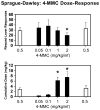

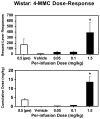
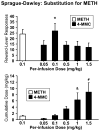
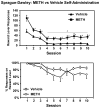

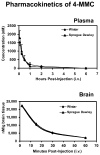
References
-
- Bird J, Schenk S. Contribution of impulsivity and novelty-seeking to the acquisition and maintenance of MDMA self-administration. Addict Biol 2012 - PubMed
-
- Bluelight 2011. (RC’s) Big mephedrone thread. 2008 [cited 1/11] Available from http://www.bluelight.ru/vb/showthread.php?t=400517.
-
- Caine SB, Lintz R, Koob GF. Intravenous drug self-administration techniques in animals. In: Sahgal A, editor. Behavioral Neuroscience: A Practical Approach. Oxford University Press; New York, NY: 1993. pp. 117–143.
Publication types
MeSH terms
Substances
Grants and funding
LinkOut - more resources
Full Text Sources
Other Literature Sources
Medical
Miscellaneous

